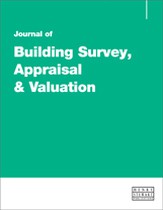Retrofit and the assessment of traditional buildings
Abstract
Retrofitting buildings will be an integral part of meeting government targets around reducing energy usage in coming years. If carried out using the correct methods and materials, with good design and installation, retrofit can be successful in improving the energy efficiency of buildings. It is important to recognise, however, that buildings can also suffer from defects if retrofit of insulation is not successful. Buildings that are of traditional construction are particularly vulnerable to defects associates with retrofit as they have particular requirements around moisture and condensation as well as ventilation. This paper considers retrofit of traditionally constructed buildings with a focus on some of the defects that may be found as a result of unsuccessful retrofit. As the volume of such work increases, so too does the likelihood that those assessing buildings will find defects related to or exacerbated by retrofit. This is not to say that traditional buildings cannot or should not be improved, as research has shown they can and should, but rather seeks to highlight a potential future cause of building defects.
The full article is available to subscribers to the journal.
Author's Biography
Moses Jenkins PhD MCIOB has worked for Historic Environment Scotland for 17 years where he is Senior Technical Officer. He has written various guidance notes over this time, most notably on the subjects of brick and energy efficiency. He gained his PhD through the study of Scottish traditional brickwork in 2017 and is a conservation accredited member of the CIOB. At present he is engaged in the development of guidance, standards and qualifications to improve knowledge of retrofit measures for traditionally constructed buildings.
Citation
Jenkins, Moses (2022, September 1). Retrofit and the assessment of traditional buildings. In the Journal of Building Survey, Appraisal & Valuation, Volume 11, Issue 2. https://doi.org/10.69554/AFLC7526.Publications LLP
